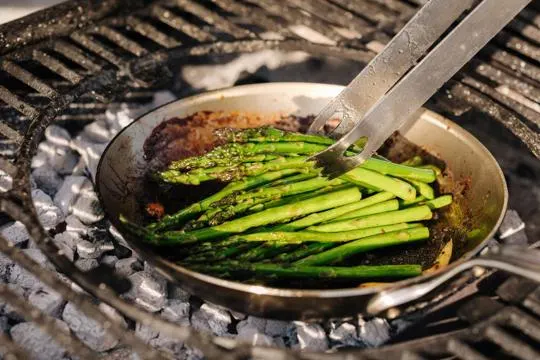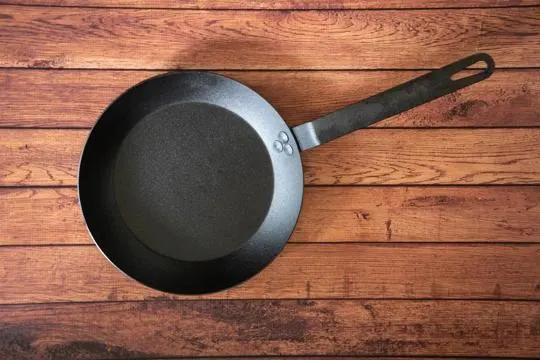Summary of key points
The main difference between blue carbon steel and regular carbon steel is in the process of how they are made. Blue carbon steel is treated with a heated mixture of water, oil, and other elements that create a blue or black oxide layer on the surface, making it more resistant to rust and corrosion.
Aside from this difference in appearance and durability, both types of carbon steel can be used in similar ways for cooking and other applications. They are known for their high heat retention and even heating, making them popular choices for use in cookware and tools. In terms of flavor, both types of steel will not impart any taste on food.
It’s important to note that the blue oxide layer on blue carbon steel may wear off over time with regular use, but this does not affect its performance in cooking. Regular maintenance and proper care can help prolong the lifespan of both types of carbon steel.
Ever scratched your head wondering about the fuss between blue carbon steel and regular carbon steel? Both pack a punch in the kitchen.
The difference? It’s all in the treatment and the performance. Blue carbon steel is the cool cousin, getting an extra step in its making to resist rust and wear.
We’ve all been there, trying to fry the perfect egg only to end up with a scene from a cooking fail compilation. This is where these materials shine, each in its unique way.
Their secrets? Locked in the atoms and the heat. Ready to find out?
What is Carbon Steel?

Carbon steel is a popular pick.
It’s known for its high carbon content.
Strength and durability make it a go-to in various industries.
Iron and carbon make it up mostly.
The carbon content usually ranges from 0.05-2%.
More carbon makes it stronger and harder.
Grades are also based on the amount of carbon present.
These grades offer properties like corrosion, abrasion, and heat resistance.
What is Blue Carbon Steel?

Blue Carbon Steel stands out due to its unique blue hue.
A special heat treatment, known as ‘blueing’, is applied to the steel to create a thin layer of magnetite.
This gives it its blue shade and improved rust resistance.
Regular carbon steel contains iron and carbon, but Blue Carbon Steel undergoes an additional step.
This makes it visually appealing and adds an extra layer of protection.
Its striking blue color makes it popular for many applications, such as in kitchen tools.
Chefs and cooking enthusiasts like its beauty and originality.
Furthermore, Blue Carbon Steel is incredibly hard and provides precise cutting.
It can be honed to a sharp edge, adding to its cutting power.
Professional chefs appreciate its sharpness and reliability.
Differences Between Blue Carbon Steel and Carbon Steel

Blue carbon steel and regular carbon steel may look the same at first glance.
But there are subtle differences between them.
Composition and Properties
Carbon steel and blue carbon steel differ.
Carbon steel is mostly made of iron and carbon, with small amounts of manganese and silicon.
Blue carbon steel has more carbon, giving it its blue color.
Strength and durability are common to both types.
Blue carbon steel wins for hardness and edge retention, making it a great choice for sharp things like knives.
Its surface has a “blue patina” from oxygen in the air, which also helps protect it from corrosion.
Plus, blue carbon steel has good heat conductivity.
This makes it perfect for cooking utensils like frying pans or woks, where even heat is needed.
In conclusion, blue carbon steel is special due to its increased carbon content and superior hardness.
That’s why it’s so popular in various industries.
Manufacturing Process
The production of blue carbon steel and carbon steel is very different.
Blue carbon steel has a unique blue color because it is heated to high temperatures and then cooled quickly with oil.
This gives the steel improved hardness, strength, and edge cutting performance.
Plus, the thin blue oxide coating adds to its durability and corrosion resistance.
Traditional carbon steel is made by melting iron ore in a blast furnace with other elements like manganese, sulfur, and phosphorus.
The molten mixture is then poured into molds to create various shapes.
While both materials are strong, their production processes make them distinct.
Blue carbon steel stands out with its enhanced properties, while traditional carbon steel stands out for its strength and rigidity.
Heat Treatment and Hardness
Heat treatment is a must.
It impacts the hardness of blue and regular carbon steel.
Through heating and cooling, the molecular structure changes, resulting in different levels of hardness.
This allows manufacturers to tailor the material’s properties for specific uses.
For blue carbon steel, the process involves quenching the metal in oil or water after it’s heated to a certain temperature.
This rapid cooling creates a hardened surface layer, yet still flexible in the core.
The outcome? A strong, durable blade that can handle heavy use without dulling.
Regular carbon steel has a different heat treatment process.
It’s heated to a higher temperature before being cooled slowly.
This allows for greater hardening and increased strength throughout the steel.
Moreover, blue carbon steel has a higher Rockwell hardness rating, meaning it has superior edge retention compared to regular carbon steel.
This means blades made with blue carbon steel will stay sharp longer, reducing the need for sharpening.
It’s important to note that while both benefit from heat treatment, blue carbon steel needs more care and maintenance to avoid rusting.
Cleaning and oiling are necessary to keep it in top condition.
Understand the differences between heat treatment methods for blue carbon steel and regular carbon steel.
The unique characteristics ensure their suitability for different purposes, from culinary knives to woodworking tools.
Appearance and Aesthetic Appeal
Steel is renowned for its strength and durability.
Its visual appeal, however, depends on the type of steel used.
Blue carbon steel and carbon steel are two popular choices.
Blue carbon steel, also known as Aogami, gets its name from a bluish hue that results from the “kurouchi” oxidation process.
This not only adds a striking color to the steel but also increases corrosion resistance.
The dark and rich hue gives blue carbon steel a distinct aesthetic appeal.
On the other hand, carbon steel is often seen in traditional knives and tools.
It has a dull grayish look, but makes up for it with versatility and practicality.
Carbon steel is sharp, durable and easy to sharpen, making it a favorite among chefs.
What sets blue carbon steel apart from regular carbon steel is not just its look but also its performance.
Blue carbon steel has a higher hardness rating due to tungsten or vanadium.
This makes for better edge retention and cutting performance.
Blue carbon steel also develops a unique patina over time called “kasumi”.
This adds to its aesthetic appeal and serves as an extra layer of protection against rusting.
Ultimately, it comes down to personal preference and specific uses.
Blue carbon steel provides a striking look with enhanced corrosion resistance and excellent cutting performance.
Regular carbon steel is sharper, more durable and easier to maintain.
Whichever option chosen, both types of steel are reliable.
Similarities Between Blue Carbon Steel and Carbon Steel

Blue carbon steel and regular carbon steel have many similarities.
Both are mainly composed of iron and carbon, and may also contain manganese, silicon, and sulfur.
This gives them great strength and durability.
Additionally, both can be formed with hot or cold forging.
Also, they are both prone to corrosion when exposed to water or certain chemicals.
So, proper maintenance is essential to protect them from oxidation.
Both can be hardened via quenching and tempering.
This increases their hardness and makes them suitable for wear-resistant applications.
Moreover, these two types of steel are popular due to their versatility and affordability.
They are used in construction, automotive manufacturing, toolmaking, and kitchenware production.
Benefits and Applications of Blue Carbon Steel and Carbon Steel
Blue carbon steel and traditional carbon steel both have their unique advantages.
Blue carbon steel is chemically treated to give it a bluish tint and enhanced corrosion resistance, making it ideal for outdoor use.
Whereas, carbon steel is known for its strength and durability.
It can withstand high temperatures and pressure, and is often used in construction and automotive manufacturing.
Blue carbon steel is better suited for marine environments and coastal regions.
It has an attractive appearance, which makes it popular in architectural projects.
Carbon steel excels in applications requiring high strength-to-weight ratio or heat resistance.
It is used for structural components like beams, columns, and reinforcement bars.
Moreover, blue carbon steel is easier to weld than traditional carbon steel, making it more favorable for fabrication work.
Maintenance and Care of Blue Carbon Steel and Carbon Steel
Blue carbon steel needs regular oiling to prevent rust. Carbon steel needs seasoning for a protective patina.
Clean with non-abrasive materials. Store in dry places. After use, dry both types of steel.
Maintenance is key to their performance and longevity.
Conclusion
In conclusion, it can be difficult to choose between blue carbon steel and carbon steel when it comes to making decisions about your project.
Both materials serve their own distinct purpose and feature their own unique properties.
When done correctly, either one can yield excellent results in terms of durability and strength.
However, before making a decision it is important to consider the use case for each material as well as the specific requirements you have for your project.
You should always be sure that the product you choose matches the needs of your specific project.
Once you have figured out all these details, choosing between blue carbon steel and carbon steel should be a lot easier.

Leave a comment